DEMetropolis and DEMetropolis(Z) Algorithm Comparisons#
import time
import arviz as az
import matplotlib.pyplot as plt
import numpy as np
import pandas as pd
import pymc as pm
import scipy.stats as st
print(f"Running on PyMC v{pm.__version__}")
WARNING (pytensor.tensor.blas): Using NumPy C-API based implementation for BLAS functions.
Running on PyMC v0+untagged.9358.g8ea092d
az.style.use("arviz-darkgrid")
rng = np.random.default_rng(1234)
Background#
For continuous variables, the default PyMC sampler (NUTS) requires that gradients are computed, which PyMC does through autodifferentiation. However, in some cases, a PyMC model may not be supplied with gradients (for example, by evaluating a numerical model outside of PyMC) and an alternative sampler is necessary. Differential evolution (DE) Metropolis samplers are an efficient choice for gradient-free inference. This notebook compares the DEMetropolis and the DEMetropolisZ samplers in PyMC to help determine which is a better option for a given problem.
The samplers are based on and ter Braak and Vrugt [2008] and are described in the notebook DEMetropolis(Z) Sampler Tuning. The idea behind differential evolution is to use randomly selected draws from other chains (DEMetropolis), or from past draws of the current chain (DEMetropolis(Z)), to make more educated proposals, thus improving sampling efficiency over the standard Metropolis implementation. Note that the PyMC implementation of DEMetropolisZ is slightly different than in ter Braak and Vrugt [2008], namely, each DEMetropolisZ chain only looks into its own history, whereas the ter Braak and Vrugt [2008] algorithm has some mixing across chains.
In this notebook, 10 and 50-dimensional multivariate normal target densities will be sampled with both DEMetropolis and DEMetropolisZ samplers. Samplers will be evaluated based on effective sample size, sampling time and MCMC chain correlation \((\hat{R})\). Samplers will also be compared to NUTS for benchmarking. Finally, MCMC traces will be compared to the analytically calculated target probability densities to assess potential bias in high dimensions.
Key Take-Aways (TL;DR)#
Based on the results in this notebook, use DEMetropolisZ for lower dimensional problems (\(\approx10D\)), and DEMetropolis for higher dimensional problems (\(\approx50D\))
The
DEMetropolisZsampler was more efficient (ESS per second sampling) thanDEMetropolis.The
DEMetropolisZsampler had better chain convergence \((\hat{R})\) thanDEMetropolis.Bias was evident in the
DEMetropolisZsampler at 50 dimensions, resulting in reduced variance compared to the target distribution.DEMetropolismore accurately sampled the high dimensional target distribution, using \(2D\) chains (twice the number of model parameters).As expected,
NUTSwas more efficient and accurate than either Metropolis-based algorithms.
Helper Functions#
This section defines helper functions that will be used throughout the notebook.
D-dimensional MvNormal Target Distribution and PyMC Model#
gen_mvnormal_params generates the parameters for the target distribution, which is a multivariate normal distribution with \(\sigma^2\) = [1, 2, 3, 4, 5] in the first five dimensions and some correlation thrown in.
make_model accepts the multivariate normal parameters mu and cov and outputs a PyMC model.
Sampling#
sample_model performs MCMC, returns the trace and the sampling duration.
calc_mean_ess calculates the mean ess for the dimensions of the distribution.
calc_mean_rhat calculates the mean \(\hat{R}\) for the dimensions of the distribution.
sample_model_calc_metrics wraps the previously defined functions: samples the model, calculates the metrics and packages the results in a Pandas DataFrame
concat_results concatenates the results and does a some data wrangling and calculating.
Plotting#
plot_comparison_bars plots the ESS and \(\hat{R}\) results for comparison.
plot_forest_compare_analytical plots the MCMC results for the first 5 dimensions and compares to the analytically calculated probability density.
plot_forest_compare_analytical_dim5 plots the MCMC results for the fift 5 dimension and compares to the analytically calculated probability density for repeated runs for the bias check.
Experiment #1. 10-Dimensional Target Distribution#
All traces are sampled with cores=1. Surprisingly, sampling was slower using multiple cores rather than one core for both samplers for the same number of total samples.
DEMetropolisZ and NUTS are sampled with four chains, and DEMetropolis are sampled with more based on ter Braak and Vrugt [2008]. DEMetropolis requires that, at a minimum, \(N\) chains are larger than \(D\) dimensions. However, {cite:t}terBraak2008differential recommends that \(2D<N<3D\) for \(D<50\), and \(10D<N<20D\) for higher dimensional problems or complicated posteriors.
The following code lays out the runs for this experiment.
# dimensions
D = 10
# total samples are constant for Metropolis algorithms
total_samples = 200000
samplers = [pm.DEMetropolisZ] + [pm.DEMetropolis] * 3 + [pm.NUTS]
coreses = [1] * 5
chainses = [4, 1 * D, 2 * D, 3 * D, 4]
# calculate the number of tunes and draws for each run
tunes = drawses = [int(total_samples / chains) for chains in chainses]
# manually adjust NUTs, which needs fewer samples
tunes[-1] = drawses[-1] = 2000
# put it in a dataframe for display and QA/QC
pd.DataFrame(
dict(
sampler=[s.name for s in samplers],
tune=tunes,
draws=drawses,
chains=chainses,
cores=coreses,
)
).style.set_caption("MCMC Runs for 10-Dimensional Experiment")
| sampler | tune | draws | chains | cores | |
|---|---|---|---|---|---|
| 0 | DEMetropolisZ | 50000 | 50000 | 4 | 1 |
| 1 | DEMetropolis | 20000 | 20000 | 10 | 1 |
| 2 | DEMetropolis | 10000 | 10000 | 20 | 1 |
| 3 | DEMetropolis | 6666 | 6666 | 30 | 1 |
| 4 | nuts | 2000 | 2000 | 4 | 1 |
results = []
run = 0
for sampler, tune, draws, cores, chains in zip(samplers, tunes, drawses, coreses, chainses):
if sampler.name == "nuts":
results.append(
sample_model_calc_metrics(
sampler, D, tune, draws, cores=cores, chains=chains, run=run, step_kwargs={}
)
)
else:
results.append(
sample_model_calc_metrics(sampler, D, tune, draws, cores=cores, chains=chains, run=run)
)
run += 1
results_df = concat_results(results)
results_df = results_df.reset_index(drop=True)
cols = results_df.columns
results_df[cols[~cols.isin(["Trace", "Run"])]].round(2).style.set_caption(
"Results of MCMC Sampling of 10-Dimensional Target Distribution"
)
| Sampler | D | Chains | Cores | tune | draws | ESS | Time_sec | ESSperSec | rhat | ESS_pct | |
|---|---|---|---|---|---|---|---|---|---|---|---|
| 0 | DEMetropolisZ | 10 | 4 | 1 | 50000 | 50000 | 6296.480000 | 127.650000 | 49.330000 | 1.000000 | 3.150000 |
| 1 | DEMetropolis | 10 | 10 | 1 | 20000 | 20000 | 3492.280000 | 147.460000 | 23.680000 | 1.000000 | 1.750000 |
| 2 | DEMetropolis | 10 | 20 | 1 | 10000 | 10000 | 5537.930000 | 156.310000 | 35.430000 | 1.000000 | 2.770000 |
| 3 | DEMetropolis | 10 | 30 | 1 | 6666 | 6666 | 5657.900000 | 166.250000 | 34.030000 | 1.010000 | 2.830000 |
| 4 | NUTS | 10 | 4 | 1 | 2000 | 2000 | 7731.260000 | 72.360000 | 106.850000 | 1.000000 | 96.640000 |
plot_comparison_bars(results_df)
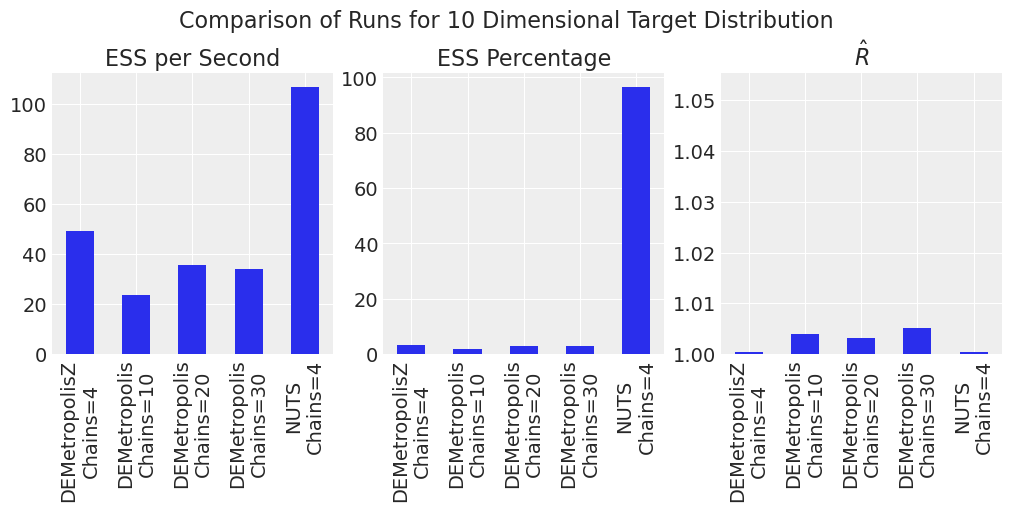
NUTs is the most efficient. DEMetropolisZ is more efficient and has lower \(\hat{R}\) than DEMetropolis.
plot_forest_compare_analytical(results_df)
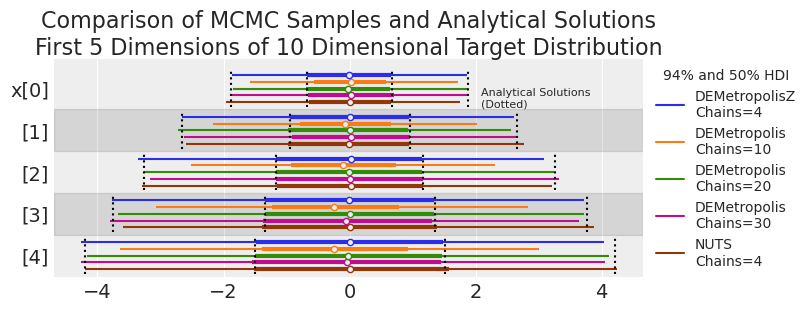
Based on the visual check, the traces have reasonably converged on the target distribution, with the exception of DEMetropolis at 10 chains, supporting the suggestion that the number of chains should be at least 2 times the number of dimensions for a 10 dimensional problem.
Experiment #2. 50-Dimensional Target Distribution#
Let’s repeat in 50-dimensions but with even more chains for the DEMetropolis algorithm.
# dimensions
D = 50
# total samples are constant for Metropolis algorithms
total_samples = 200000
samplers = [pm.DEMetropolisZ] + [pm.DEMetropolis] * 3 + [pm.NUTS]
coreses = [1] * 5
chainses = [4, 2 * D, 10 * D, 20 * D, 4]
# calculate the number of tunes and draws for each run
tunes = drawses = [int(total_samples / chains) for chains in chainses]
# manually adjust NUTs, which needs fewer samples
tunes[-1] = drawses[-1] = 2000
# put it in a dataframe for display and QA/QC
pd.DataFrame(
dict(
sampler=[s.name for s in samplers],
tune=tunes,
draws=drawses,
chains=chainses,
cores=coreses,
)
).style.set_caption("MCMC Runs for 50-Dimensional Experiment")
| sampler | tune | draws | chains | cores | |
|---|---|---|---|---|---|
| 0 | DEMetropolisZ | 50000 | 50000 | 4 | 1 |
| 1 | DEMetropolis | 2000 | 2000 | 100 | 1 |
| 2 | DEMetropolis | 400 | 400 | 500 | 1 |
| 3 | DEMetropolis | 200 | 200 | 1000 | 1 |
| 4 | nuts | 2000 | 2000 | 4 | 1 |
results = []
run = 0
for sampler, tune, draws, cores, chains in zip(samplers, tunes, drawses, coreses, chainses):
if sampler.name == "nuts":
results.append(
sample_model_calc_metrics(
sampler,
D,
tune,
draws,
cores=cores,
chains=chains,
run=run,
step_kwargs={},
sample_kwargs=dict(nuts=dict(target_accept=0.95)),
)
)
else:
results.append(
sample_model_calc_metrics(sampler, D, tune, draws, cores=cores, chains=chains, run=run)
)
run += 1
results_df = concat_results(results)
results_df = results_df.reset_index(drop=True)
cols = results_df.columns
results_df[cols[~cols.isin(["Trace", "Run"])]].round(2).style.set_caption(
"Results of MCMC Sampling of 50-Dimensional Target Distribution"
)
| Sampler | D | Chains | Cores | tune | draws | ESS | Time_sec | ESSperSec | rhat | ESS_pct | |
|---|---|---|---|---|---|---|---|---|---|---|---|
| 0 | DEMetropolisZ | 50 | 4 | 1 | 50000 | 50000 | 1309.830000 | 163.870000 | 7.990000 | 1.000000 | 0.650000 |
| 1 | DEMetropolis | 50 | 100 | 1 | 2000 | 2000 | 792.730000 | 236.830000 | 3.350000 | 1.090000 | 0.400000 |
| 2 | DEMetropolis | 50 | 500 | 1 | 400 | 400 | 1083.880000 | 415.260000 | 2.610000 | 1.410000 | 0.540000 |
| 3 | DEMetropolis | 50 | 1000 | 1 | 200 | 200 | 1616.890000 | 633.760000 | 2.550000 | 1.710000 | 0.810000 |
| 4 | NUTS | 50 | 4 | 1 | 2000 | 2000 | 10570.020000 | 105.300000 | 100.380000 | 1.000000 | 132.130000 |
plot_comparison_bars(results_df)
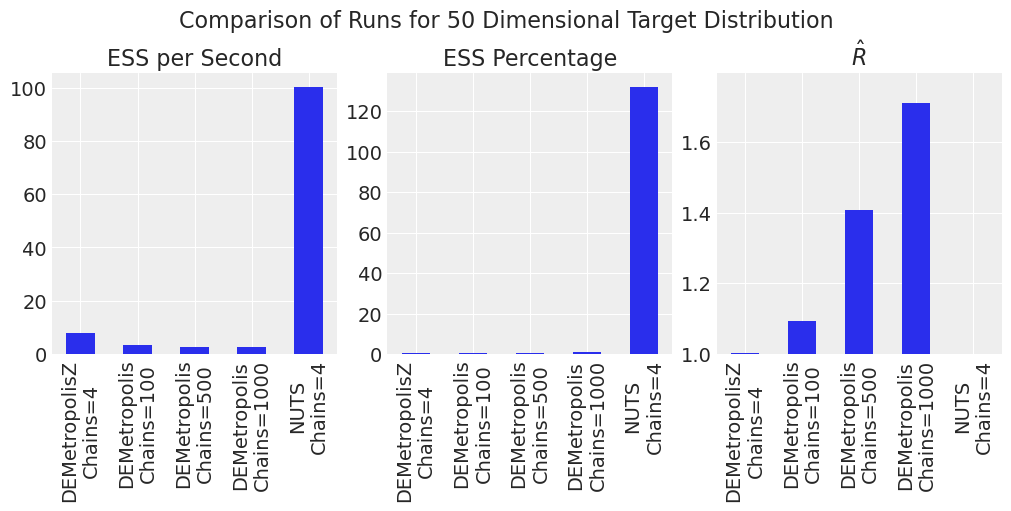
The efficiency advantage for NUTS over DEMetropolisZ over DEMetropolis is more pronounced in higher dimensions. \(\hat{R}\) is also large for DEMetropolis for this sample size and number of chains. For DEMetropolis, a smaller number of chains (\(2N\)) with a larger number of samples performed better than more chains with fewer samples. Counter-intuitively, the NUTS sampler yields \(ESS\) values greater than the number of samples, which can occur as discussed here.
plot_forest_compare_analytical(results_df)
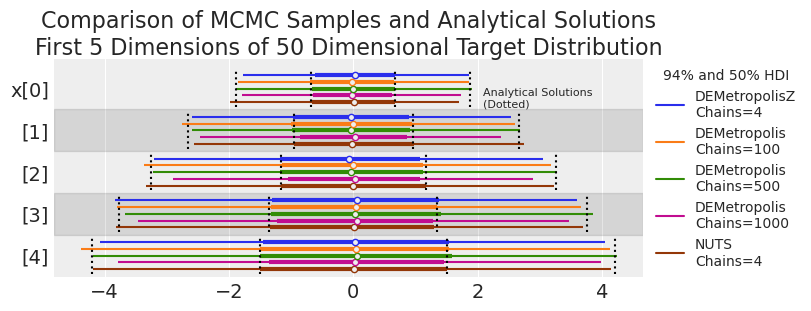
We might be seeing low coverage in the tails of some DEMetropolis runs (i.e., the MCMC HDIs are consistently smaller than the analytical solution). Let’s explore this more systematically in the next experiment.
Experiment #3. Accuracy and Bias#
We want to make sure that the DEMetropolis samplers are providing coverage for high dimensional problems (i.e., the tails are appropriately sampled). We will test for bias by running the algorithm multiple times and comparing to both NUTS and the analytically-calculated probability density. We will perform MCMC in many dimensions but analyze the results for the dimension with the most variance (dimension 5) for simplicity.
10 Dimensions#
First check in 10 dimensions. We will perform 10 replicates for each run. DEMetropolis will be run at \(2D\) chains. The number of tunes and draws have been tailored to get effective sampler sizes of greater than 2000.
D = 10
reps = 10
samplers = [pm.DEMetropolis] * reps + [pm.DEMetropolisZ] * reps + [pm.NUTS] * reps
coreses = [1] * reps * 3
chainses = [2 * D] * reps + [4] * reps * 2
tunes = drawses = [5000] * reps + [25000] * reps + [1000] * reps
results = []
run = 0
for sampler, tune, draws, cores, chains in zip(samplers, tunes, drawses, coreses, chainses):
if sampler.name == "nuts":
results.append(
sample_model_calc_metrics(
sampler,
D,
tune,
draws,
cores=cores,
chains=chains,
run=run,
step_kwargs={},
sample_kwargs=dict(target_accept=0.95),
)
)
else:
results.append(
sample_model_calc_metrics(sampler, D, tune, draws, cores=cores, chains=chains, run=run)
)
run += 1
results_df = concat_results(results)
results_df = results_df.reset_index(drop=True)
summaries, summary_means = plot_forest_compare_analytical_dim5(results_df)
summary_means.style.set_caption(
"MCMC and Analytical Results for 5th Dimension of 10 Dimensional Target Distribution"
)
| mean | sd | hdi_3% | hdi_97% | ess_bulk | ess_tail | r_hat | |
|---|---|---|---|---|---|---|---|
| Sampler | |||||||
| DEMetropolis | -0.021700 | 2.214500 | -4.125400 | 4.174200 | 2772.400000 | 5331.700000 | 1.010000 |
| DEMetropolisZ | -0.000200 | 2.226000 | -4.188600 | 4.159800 | 3089.100000 | 5587.200000 | 1.000000 |
| NUTS | 0.001400 | 2.257800 | -4.252700 | 4.196400 | 2618.100000 | 2798.000000 | 1.000000 |
| Analytical | 0.000000 | 2.236068 | -4.205582 | 4.205582 | nan | nan | nan |
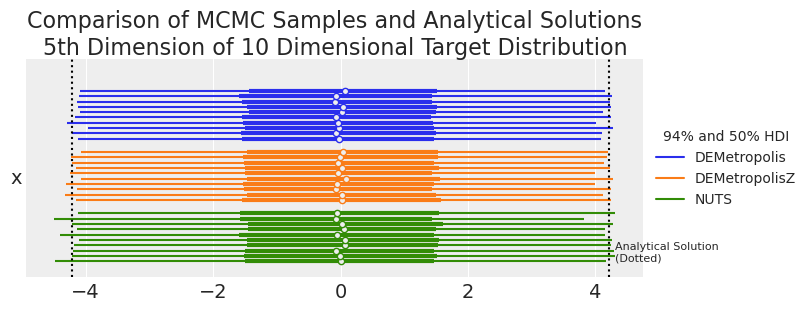
Visually, DEMetropolis algorithms look as reasonable accurate and as accurate as NUTS. Since we have 10 replicates that we want to compare to the analytical solution, we can dust off our traditional statistics and perform an old-school one-sided t-test to see if the sampler-calculated confidence limits are significantly different than the analytically calculated confidence limit.
samplers = ["DEMetropolis", "DEMetropolisZ", "NUTS"]
cls_str = ["hdi_3%", "hdi_97%"]
cls_val = [0.03, 0.97]
dist = st.norm(0, np.sqrt(5))
results = []
for sampler in samplers:
for cl_str, cl_val in zip(cls_str, cls_val):
mask = summaries.Sampler == sampler
# collect the credible limits for each MCMC run
mcmc_cls = summaries.loc[mask, cl_str]
# calculate the confidence limit for the target dist
analytical_cl = dist.ppf(cl_val)
# one sided t-test!
p_value = st.ttest_1samp(mcmc_cls, analytical_cl).pvalue
results.append(
pd.DataFrame(dict(Sampler=[sampler], ConfidenceLimit=[cl_str], Pvalue=[p_value]))
)
pd.concat(results).style.set_caption(
"MCMC Replicates Compared to Analytical Solution for Selected Confidence Limits"
)
| Sampler | ConfidenceLimit | Pvalue | |
|---|---|---|---|
| 0 | DEMetropolis | hdi_3% | 0.018270 |
| 0 | DEMetropolis | hdi_97% | 0.307391 |
| 0 | DEMetropolisZ | hdi_3% | 0.555155 |
| 0 | DEMetropolisZ | hdi_97% | 0.177881 |
| 0 | NUTS | hdi_3% | 0.336053 |
| 0 | NUTS | hdi_97% | 0.847152 |
A higher p-value indicates that the MCMC algorithm captures the analytical value with high confidence. A lower p-value means that the MCMC algorithm was unexpectedly high or low compared to the analytically calculated confidence limit. The NUTS sampler is capturing the analytically calculated value with high confidence. The DEMetropolis algorithms have lower confidence but are giving reasonable results.
50 Dimensions#
Higher dimensions get increasingly difficult for Metropolis algorithms. Here we will sample with very large sample sizes (this will take a while) to get at least 2000 effective samples.
D = 50
reps = 10
samplers = [pm.DEMetropolis] * reps + [pm.DEMetropolisZ] * reps + [pm.NUTS] * reps
coreses = [1] * reps * 3
chainses = [2 * D] * reps + [4] * reps * 2
tunes = drawses = [5000] * reps + [100000] * reps + [1000] * reps
results = []
run = 0
for sampler, tune, draws, cores, chains in zip(samplers, tunes, drawses, coreses, chainses):
if sampler.name == "nuts":
results.append(
sample_model_calc_metrics(
sampler,
D,
tune,
draws,
cores=cores,
chains=chains,
run=run,
step_kwargs={},
sample_kwargs=dict(target_accept=0.95),
)
)
else:
results.append(
sample_model_calc_metrics(sampler, D, tune, draws, cores=cores, chains=chains, run=run)
)
run += 1
results_df = concat_results(results)
results_df = results_df.reset_index(drop=True)
summaries, summary_means = plot_forest_compare_analytical_dim5(results_df)
summary_means.style.set_caption(
"MCMC and Analytical Results for 5th Dimension of 50 Dimensional Target Distribution"
)
| mean | sd | hdi_3% | hdi_97% | ess_bulk | ess_tail | r_hat | |
|---|---|---|---|---|---|---|---|
| Sampler | |||||||
| DEMetropolis | -0.007700 | 2.236900 | -4.224400 | 4.178500 | 2583.200000 | 5619.600000 | 1.034000 |
| DEMetropolisZ | -0.009700 | 2.172500 | -4.088500 | 4.079600 | 2616.800000 | 5408.700000 | 1.000000 |
| NUTS | 0.030000 | 2.244200 | -4.235000 | 4.144900 | 2552.600000 | 2811.200000 | 1.000000 |
| Analytical | 0.000000 | 2.236068 | -4.205582 | 4.205582 | nan | nan | nan |
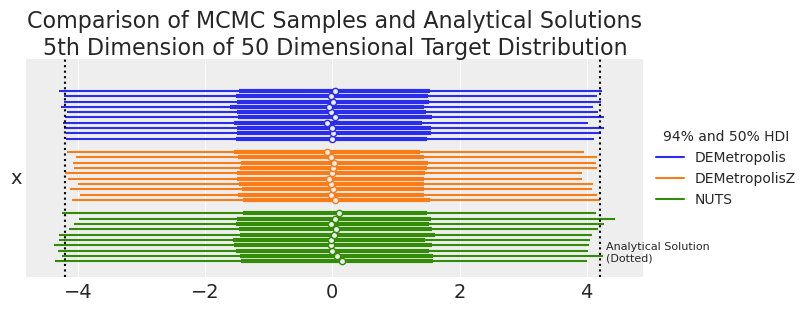
samplers = ["DEMetropolis", "DEMetropolisZ", "NUTS"]
cls_str = ["hdi_3%", "hdi_97%"]
cls_val = [0.03, 0.97]
results = []
for sampler in samplers:
for cl_str, cl_val in zip(cls_str, cls_val):
mask = summaries.Sampler == sampler
# collect the credible limits for each MCMC run
mcmc_cls = summaries.loc[mask, cl_str]
# calculate the confidence limit for the target dist
analytical_cl = dist.ppf(cl_val)
# one sided t-test!
p_value = st.ttest_1samp(mcmc_cls, analytical_cl).pvalue
results.append(
pd.DataFrame(dict(Sampler=[sampler], ConfidenceLimit=[cl_str], Pvalue=[p_value]))
)
pd.concat(results).style.set_caption(
"MCMC Replicates Compared to Analytical Solution for Selected Confidence Limits"
)
| Sampler | ConfidenceLimit | Pvalue | |
|---|---|---|---|
| 0 | DEMetropolis | hdi_3% | 0.152028 |
| 0 | DEMetropolis | hdi_97% | 0.318463 |
| 0 | DEMetropolisZ | hdi_3% | 0.001217 |
| 0 | DEMetropolisZ | hdi_97% | 0.005154 |
| 0 | NUTS | hdi_3% | 0.490542 |
| 0 | NUTS | hdi_97% | 0.212516 |
We can see that at 50 dimensions, the DEMetropolisZ sampler has poor coverage compared to DEMetropolis. Therefore, even though DEMetropolisZ is more efficient and has lower \(\hat{R}\) values than DEMetropolis, DEMetropolis is suggested for higher dimensional problems.
Conclusion#
Based on the results in this notebook, if you cannot use NUTS, use DEMetropolisZ for lower dimensional problems (e.g., \(10D\)) because it is more efficient and converges better. Use DEMetropolis for higher dimensional problems (e.g., \(50D\)) to better capture the tails of the target distribution.
%load_ext watermark
%watermark -n -u -v -iv -w
Last updated: Fri Feb 10 2023
Python implementation: CPython
Python version : 3.11.0
IPython version : 8.7.0
pymc : 5.0.1+5.ga7f361bd
numpy : 1.24.0
pandas : 1.5.2
sys : 3.11.0 | packaged by conda-forge | (main, Oct 25 2022, 06:12:32) [MSC v.1929 64 bit (AMD64)]
matplotlib: 3.6.2
scipy : 1.9.3
arviz : 0.14.0
Watermark: 2.3.1
